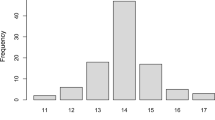Abstract
A simulation model has been developed for predicting the distribution of trinucleotide repeat expansion diseases in human populations. The interface of the software used to run this model presents the options for simulating natural reproduction of a population, with the population demographic parameters taken into account, and for simulating the appearance of a dynamic mutation in populations, transmission of the mutant gene from parents to offspring, and the effect of the phenotypic expression of the disease (the patients’ life expectancy and birthrate) on the transmission of the mutant allele in the patients’ families and its accumulation in the population.
Similar content being viewed by others
References
Orr, H., Chung, M.-Y., Banfi, S., et al., Expansion of an Unstable Trinucleotide GAG Repeat in Spinocerebellar Ataxia Type 1, Nat. Genet., 1993, vol. 4, pp. 221–226.
Zoghbi, H.Y. and Orr, H.T., Pathogenic Mechanisms of a Polyglutamine Mediated Neurodegenerative Disease: SCA1, J. Biol. Chem., 2009, vol. 284, pp. 7425–7429.
Goldfarb, L.G., Vasconcelos, O., Platonov, F.A., et al., Unstable Triplet Repeat and Phenotypic Variability of Spinicerebellar Ataxia Type 1, Ann. Neurol., 1996, vol. 39, pp. 500–506.
Sobczak, K. and Krzyzosiak, W.J., Patterns of CAG Repeat Interruptions in SCA1 and SCA2 Genes in Relation to Repeat Instability, Hum. Mutat., 2004, vol. 24, pp. 236–247.
Gorbunova, V.N., Savel’eva-Vasil’eva, E.A., and Krasil’nikov, V.V., Molekulyarnaya nevrologiya (zabolevaniya koordinatornoi, piramidnoi i ekstrapiramidnoi sistem, bolezni ekspansii) (Molecular Neurology: Coordination Disorders, Diseases of the Pyramidal and Extrapyramidal Systems, and Expansion Diseases), St. Petersburg: Intermedika, 2002.
Platonov, F.A., Hereditary Spinicerebellar Ataxia in Yakutia, Extended Abstract of Doctoral (Med.) Dissertation, Moscow, 2003.
Kucher, A.N., Danilova, A.L., Koneva, L.A., et al., Genetic Demographic Study of the Population of the Republic of Sakha (Yakutia), Yakutsk. Med. Zh., 2005, vol. 2,no. 10, pp. 4–12.
Strel’nikov, V.V. and Zaletaev, D.V., Molecular Mechanisms of Etiopathogenesis of Expansion Diseases, Genomikameditsine (Genomics for Medicine), Moscow: Akademkniga, 2005.
Sukneva, S.A. and Mostakhova, T.S., Demograficheskoe razvitie regiona: otsenka, prognoz, politika (Demographic Development of a Region: Assessment, Prediction, and Policies), Novosibirsk: Nauka, 2002.
Author information
Authors and Affiliations
Corresponding author
Additional information
Original Russian Text © L.A. Koneva, A.V. Konev, A.N. Kucher, 2010, published in Genetika, 2010, Vol. 46, No. 3, pp. 417–424.
Rights and permissions
About this article
Cite this article
Koneva, L.A., Konev, A.V. & Kucher, A.N. Simulation of the distribution of spinocerebellar ataxia type 1 in Yakut populations: Description of the model. Russ J Genet 46, 370–376 (2010). https://doi.org/10.1134/S1022795410030154
Received:
Published:
Issue Date:
DOI: https://doi.org/10.1134/S1022795410030154




